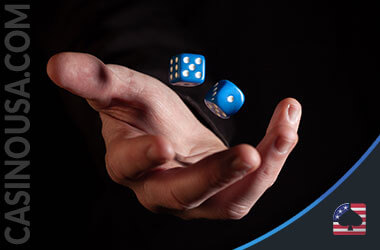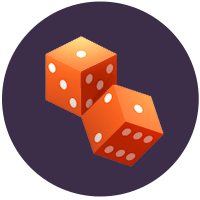
Probability is one of the ways we humans try to understand the randomness of the universe. In fact, we deal with chances all the time, using our judgment to determine how probable something is. For example, if it’s January in Europe, it’s cold, and there are a lot of clouds, saying something like “it might snow today” is a statement that has to deal with probability.
In gambling, probability is the primary fuel behind every game, and players often try to put it to numbers to understand how likely they are to get a prize.
In this article, we’ll discuss probability in gambling and how it’s related to odds, a more common term gamblers use.
What we will cover:
- What Probability in Gambling is
- What Odds in Gambling is
- How to Convert Odds to Probability
- Which of the Two Is More Important
What Is Probability in Gambling?
![]() Probability in gambling is shown in percentages, which determine how likely a particular event will occur.
Probability in gambling is shown in percentages, which determine how likely a particular event will occur.
Imagine you’re playing soccer and are shooting free kicks in the goal. After ten tries, the ball meets the goal net seven times, and a person observing your performance will say that you have a 70% probability of scoring in the future.
This was quite a straightforward scenario, and it gets a bit more complicated than that when calculating the probability in casino games or sports betting events, as various elements are considered. However, it all comes down to figuring out how likely an event will happen. That’s essentially what probability is.
What Are Odds in Gambling?

Let’s take the same scenario as above — free kicks. Same position, same environment. You score seven out of ten, which is 70% probability, but what are the odds?
As it turns out, the odds just tell you the same thing, but the format is different. In this case, you’ll have the odds of 1/7 if you were to make a free kick for the eleventh time.
But, let’s get one thing out of the way — the odds we just described aren’t the same odds you’ll see in online sports betting sites and casinos. There are several types of odds.
What we described above are the so-called true odds that depict the likelihood. However, online gambling sites often need to profit from the games you play, which is why they show you the payout odds. In other words, they tell you how much you will likely win by making a bet.
Imagine a coin flip, which gives you a 50% chance to win. In true odds, that would be 1/1, and your payout would be doubled. In other words, you should double your wager if you win, which is represented as 2.0 in decimal odds.
However, the house always needs to win at the end, which means that the payout odds won’t be true. Instead, you’ll see something like 1.8. In other words, if you bet $10, you’ll get an $8 profit (instead of $10) on a game where you have a 50% chance of winning. The remaining 0.2 will remain as a profit for the house.
How to Convert Odds to Probability
As you know, there are three ways to represent the odds — decimal, fractional, and American. Here’s a formula on how to convert each of them into probability.
- Decimal — You need to divide 1 by the decimal odds at hand. After that, multiply the result by 100, and you’ll get the real percentage. For example, if the decimal odds are 2.0, you need to divide it by 1/2. The result (0.50) needs to be multiplied by 100 to get 50% as the final result.
- Fractional — You need to divide 1 by the fractional odds plus one. For example, if the fractional odds are 3/1, you need to do the following: 1 / (3/1) + 1. Finally, the result needs to be multiplied by 100. In this case, the result will be 25%.
- American — For the American odds, the process is different depending on whether you use positive or negative odds.
- Positive American odds — You need to divide 100 by the positive odds + 100. Therefore, if the odds are 150, you need to start by doing this 100 / (150 + 100). Finally, you need to multiply the result by 100. In this case, the result is 40%.
- Negative American odds — First of all, you need to multiply the negative odds by -1. For example, if the odds are -300, you need to make them 300. After that, divide these odds by the same number + 100. That would look something like this: 300/(300+100). Like in all other formulas, the last step is to multiply the result by 100. In this case, the result will be 75%
Remember that you’ll still convert the payout odds into probability, while the real probability might be somewhat different.
Conclusion: What Is More Important — Odds or Probability?

As you can see, odds are the same thing as probability, only shown in a different form. However, things are never that easy, as the term odds doesn’t often refer to the real probability but rather your payout for the placed bet, and the payout odds are always a bit different compared to the real odds.
Ideally, you should learn about probability and the payout odds to truly understand the likelihood of winning and the possible rewards you might get if you win.
Even though it seems there’s a lot of math involved, converting odds to probability and vice versa becomes relatively easy once you get into the swing of things. Every casino player, poker player, or sports bettor, makes sure to understand the math behind every game they play or bet they make to ensure they are making the right move.
As a beginner, this might not matter much, but knowing the difference between probability and the odds is essential if you aim to become an experienced gambler.




